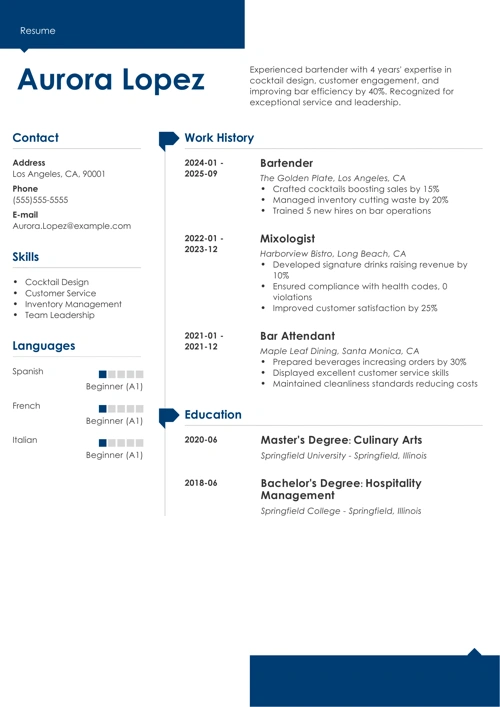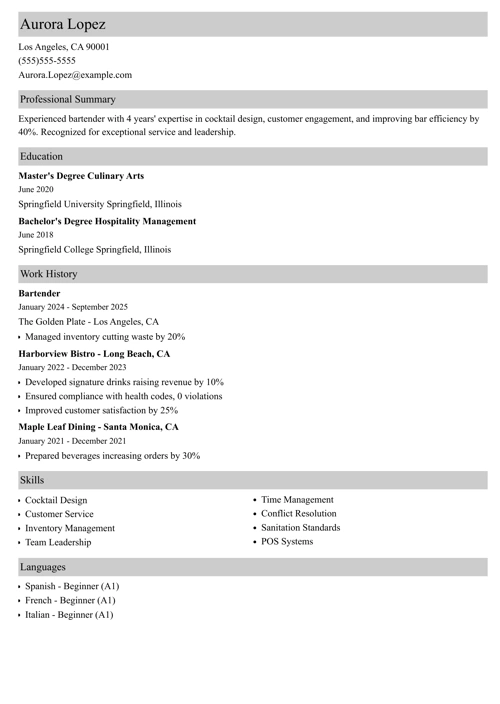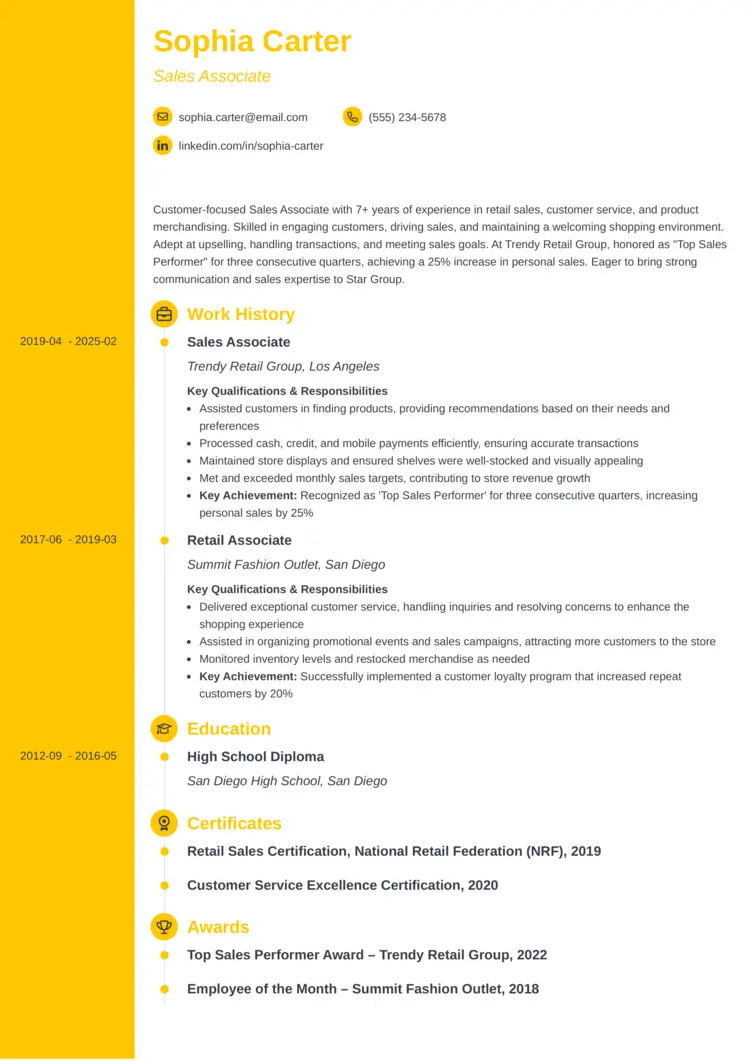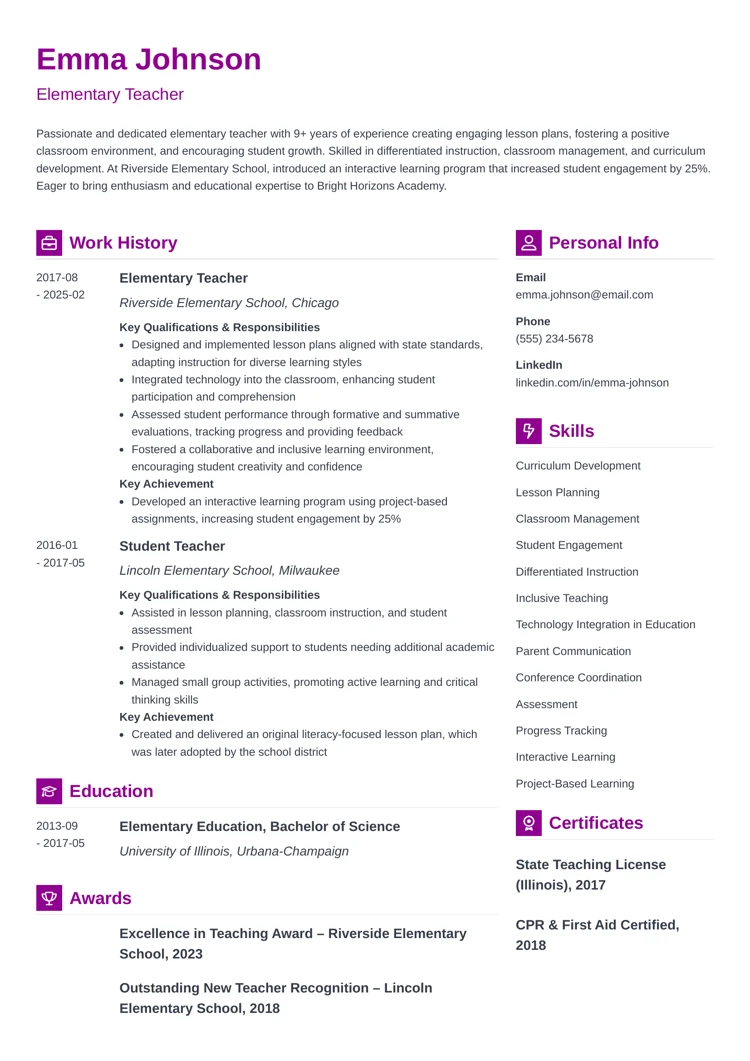Choosing the right resume format can feel like picking the best route on a map: You want the one that gets you to the interview the fastest. For most job seekers, that route is the chronological resume.
It’s clear, familiar, and preferred by almost all hiring managers because it shows your career growth step-by-step, starting with your most recent job.
In this guide, we’ll walk you through what a chronological resume is, when to use it, and how to write it with some examples and templates.
Want to save time and have your resume ready in 5 minutes? Try our resume builder. It’s fast and easy to use. Plus, you’ll get ready-made content to add with one click. See 20+ resume templates and create your resume here.
Sample resume made with our builder—See more resume examples here.
What Is a Chronological Resume?
A chronological resume is a resume format that highlights your work experience and career growth. Also called a reverse chronological resume, it lists your job history from your most recent position backward.
This format places your work experience section just below your professional summary, putting your career achievements front and center.
Chronological Resume Example
When to Use a Chronological Resume
Chronological resumes are the most commonly used format, and hiring managers often prefer them. They make it easy for employers to quickly see where you’ve worked and how your skills have grown over time.
This format works best if you have several years of relevant work experience in the field you will be applying for. By placing your work history at the top, you can lead with your career growth to make a strong first impression.
Pro tip: If you have limited experience or are changing careers, try a functional resume format to highlight your skills instead.
Chronological resume pros & cons
Still unsure whether you should use a chronological format? Consider these pros and cons:
| Pros |
|---|
|
| Cons |
|---|
|
How to Write a Chronological Resume
All resumes feature the same sections; it's just the order that changes. Let's go over how to write your resume, the chronological way:
Create your resume header
Your resume header is essential for hiring managers to contact you and set up an interview. Here's what to include:
- Full name
- Job title
- Phone number
- ZIP code, city, and state
- LinkedIn or Bold.pro profile, if applicable
- Online portfolio, if applicable
Write a professional summary
A resume summary is a quick overview of your most impressive accomplishments and skills. In three to four sentences, highlight what makes you a strong candidate.
Here's an example:
Results-driven supply chain manager with seven years of experience leading end-to-end supply chain operations in fast-paced environments. Proven expertise in logistics optimization, inventory management, demand forecasting, and vendor relationship management. Successfully implemented process improvements that reduced operational costs by 15% while improving delivery times and efficiency. Skilled at leading cross-functional teams to deliver projects on time and align operations with strategic business objectives.
Highlight your work experience
The work experience section is the core of your chronological resume. Take your time to make sure it includes all the details that showcase your value as an employee.
List your past roles in reverse-chronological order, starting with your most recent one. Write down your job duties in bullet points, and include quantifiable accomplishments whenever possible. To drive impact, start each bullet point with an action verb.
Here's an example:
Supply Chain Manager | Rideau Logistics
New York, NY | Jan 2018 – Present
- Manage end-to-end supply chain operations for a $50M product portfolio, overseeing logistics, inventory, procurement, and vendor relations.
- Develop and execute process improvement initiatives that increase supply chain efficiency and support company growth targets.
Key achievements:
- Implemented a new demand forecasting system, reducing stockouts by 20% and cutting excess inventory by 15%.
- Led a cross-functional team of 12 to streamline warehouse operations, improving order fulfillment speed by 25% and reducing delivery errors by 30%.
- Negotiated contracts with key suppliers, achieving cost savings of $1.2M annually while maintaining quality standards.
List your skills
Your skills list is an effective way to highlight the hard and soft skills essential to your target role. Write down six to eight skills that showcase your strengths. For example:
- Logistics and distribution
- Inventory management
- Demand forecasting
- Vendor and supplier management
- Leadership and team management
- Problem-solving
- Strategic thinking
- Strong written and verbal communication
Pro tip: Read the job description to find the key skills the employer is looking for and add them to your resume. Including the keywords that describe the ideal candidate in your resume will help your application pass applicant tracking systems (ATS).
Showcase your education
Your education section helps employers see the foundation of your skills and expertise. List your most recent degree first, including your school, degree name, and graduation date. Here's an example:
Master of Business Administration (MBA) | New York University
Graduated: May 2016
Bachelor of Science in Supply Chain Management | University of Michigan
Graduated: May 2012
Add optional sections
Optional sections can give your resume an extra boost, especially if they're relevant to the job. Here are a few sections you can include:
- Certifications: Professional certifications or licenses that support your role
- Languages: Any languages you speak and your proficiency level, which can be valuable in global or multilingual workplaces
- Volunteer experience: Community involvement or leadership in nonprofit work, especially if it relates to your skills
- Hobbies and interests: Professional and relevant hobbies that demonstrate soft skills, creativity, or leadership
- Publications or presentations: Articles, reports, or conference presentations that showcase expertise in your field
- Professional memberships: Memberships in industry organizations that show your engagement and ongoing learning
Making a resume with our builder is incredibly simple. Follow our step-by-step guide, use ready-made content tailored to your job and have a resume ready in minutes.
When you’re done, Zety’s Resume Builder will score your resume and our Resume Checker will tell you exactly how to make it better.
Chronological Resume Samples for Popular Jobs
Check out these chronological resume examples to see how other job seekers showcase their work experience:
Manager resume example
Sales associate resume example
Elementary teacher resume example
Chronological Resume Template
[Full Name]
[Job Title]
[Email Address]
[Phone Number]
[City, State, ZIP]
[LinkedIn / Online Portfolio]
Professional Summary
[Three to four sentences highlighting your experience, skills, and accomplishments.]
Work Experience
[Job Title] | [Company Name]
[City, State] | [Start Date] – [End Date]
[Key responsibility]
[Key responsibility]
[Key responsibility]
Key achievements:
[Achievement]
[Achievement]
[Achievement]
[Job Title] | [Company Name]
[City, State] | [Start Date] – [End Date]
[Key responsibility]
[Key responsibility]
[Key responsibility]
Key achievements:
[Achievement]
[Achievement]
[Achievement]
Education
[Degree] | [School Name]
[Graduation Date]
Skills
- [Skill 1]
- [Skill 2]
- [Skill 3]
- [Skill 4]
- [Skill 5]
- [Skill 6]
Optional Sections
- Certifications: [Certification Name, Issuing Organization, Year]
- Languages: [Language – Proficiency Level]
- Volunteer Experience: [Organization – Role – Dates]
- Hobbies & Interests: [Relevant Activities]
- Publications or Presentations: [Title – Publication / Event – Year]
- Professional Memberships: [Organization Name – Role / Membership Type]
Key Takeaways
Now that you know what a chronological resume is and when to use it, let’s wrap it up with some key points:
- A chronological resume places your work experience front and center, starting with your most recent job.
- This format is best for job seekers with steady work experience in a field relevant to the job they’re applying for who want to highlight career growth.
- The work experience section is the core of a chronological resume and should focus on accomplishments rather than just job duties.
- Start each bullet point in your work history with a strong action verb and include numbers when possible to show impact.
- While this format is easy for employers to read and preferred by hiring managers, it can make gaps in employment, lack of relevant experience, or career changes more noticeable.
- Include education, skills, and optional sections like certifications or volunteer work to give a complete picture of your qualifications.
About Zety’s Editorial Process
This article has been reviewed by our editorial team to make sure it follows Zety's editorial guidelines. We’re committed to sharing our expertise and giving you trustworthy career advice tailored to your needs. High-quality content is what brings over 40 million readers to our site every year. But we don't stop there. Our team conducts original research to understand the job market better, and we pride ourselves on being quoted by top universities and prime media outlets from around the world.







